UPDATE II: More history on the Worman company in the January 1948 issue of Wilys Overland Sales News.
UPDATE: This article appeared in the 2016 Winter edition of Dispatcher Magazine. The original of this was posted in October of 2106 as a series of notes, but is now updated with text from that article along with some additional photos.
Willys-Overland equipment manufacturers experienced a range of successes and failures. One of those who entered the market at the dawn of the CJ-2A to achieve the former was Laurel C. Worman, a businessman who created the first set of jeep hardtops for different applications, most sold under the brand Jee-Cab.
EARLY YEARS OF LAUREL C. WORMAN:
Laurel C. Worman was born in 1898 in Toledo, Ohio, to Ernest and Clara Worman. He was the younger of two children. The boy’s father Ernest was a self-made man, who developed a large hardwood lumber business, something Laurel must have watched with fascination. When he was old enough, Laurel married Muriel Florence Jackson. The pair had two sons, Ernest “Ernie” William and Lester Lee Worman. The couple later divorced. By 1940, Laurel had remarried a woman named Ruth.
Perhaps Laurel’s father’s entrepreneurial influence led him to become a self-made man himself. While his early employment history has yet to be unearthed, by 1941, Laurel was president of Packard Toledo, Inc. Well known in Toledo automotive circles, Laurel later that year became a northwestern Ohio distributor for the new Willys Americar. It may have been the car that interested him most, but more likely it was the potential of the jeep, which had garnered automotive interest for more than a year.
About this time in 1941, Laurel C. Worman incorporated a company by the same name, under which he placed the Willys dealership. It was only one of several companies he would co-found. In December 1941, he went to Washington, D. C., as a dealer representative and gathered with other auto industry to reps to establish a ceiling on car prices, perhaps in anticipation of war. Four days after returning from his D. C. meeting, the Japanese struck Pearl Harbor.
The war doesn’t appear to have slowed Worman down. By 1942, he was placing ads in the Toledo Blade, arguing how “Willys Truck Owners Are Lucky!” Laurel noted that Willys-Overland had produced the most economical line of trucks. He told potential customers they would be well-served by the truck’s low use of gasoline and their rugged nature, two characteristics important for enduring war time challenges. Worman also made sure to note that Willys was the producer of the jeep, already famous by September of 1942.
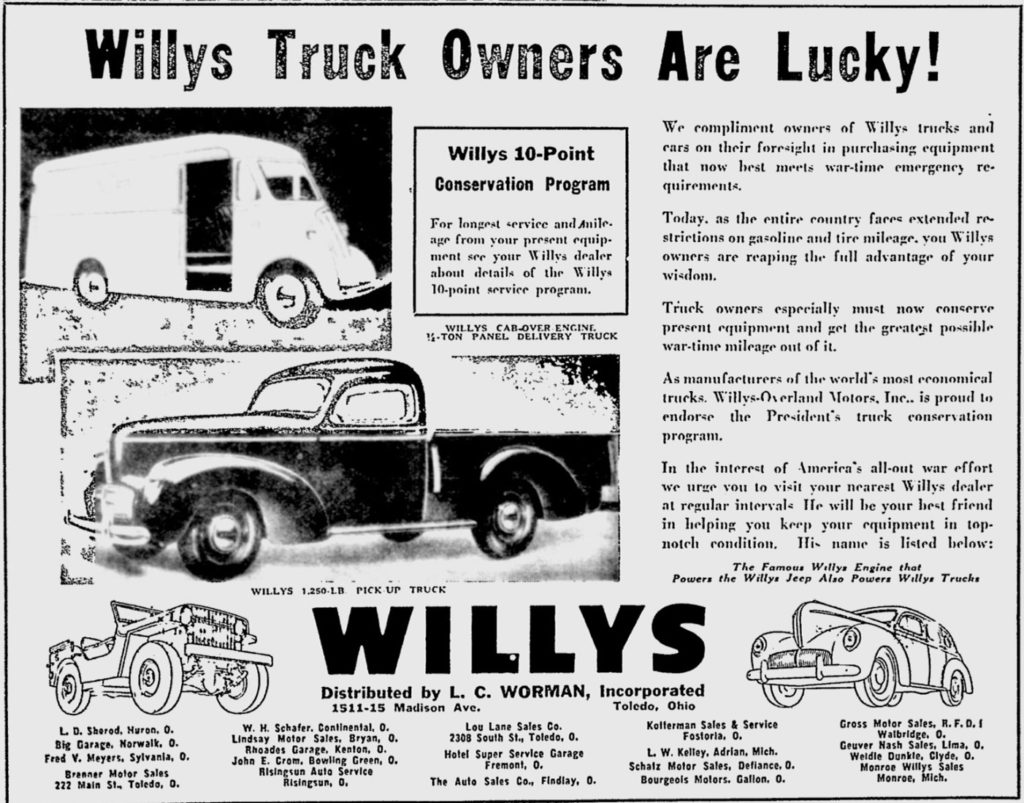
As an automotive dealer seemingly in the thick of things in Toledo during WWII, there’s no evidence he formed plans for any jeep equipment. But, as a Willys dealer in Toledo, he certainly would have stayed abreast of the CJ’s progress and must have saw potential in the jeep following the war.
THE CJ-2A ARRIVES:
When the CJ-2A was introduced to the public in July of 1945, options included a front soft top ($55) and rear soft top ($39). The first civilian hardtop half-cab, according to Fred Coldwell in his Preproduction Civilian Jeep book, didn’t go into production until the fall of 1945. Somewhere around that time, the Army asked Willys-Overland to design a full steel cab for the late 1945 MBs. The result was a stretched version of the half cab, but it never went into production. One probable reason was that steel was in short supply. Another reason was that they were heavy.
In August 1945, Worman invited prospective buyers to visit his dealership and see the new “Universal ‘Jeep’” for themselves. The amazing “4-in-1” vehicle was advertised as a light truck, a light tractor, a runabout, and a mobile power unit. But, it still lacked the comfort of a full cab, a fact that must have been apparent to Worman as he engaged customers and sold jeeps through ’45 and into ’46.

Perhaps after hearing from dealers and customers that they’d prefer a hard top over the canvas front and rear tops, the Willys-Overland decided to contract with Laurel C. Worman to produce a line of hardtops. The hardtops would be made of aluminum, which, unlike steel, was amply available and light.
In anticipation of handling and displaying Willys-Overland products, Worman, through Hoppe & Worman, Inc., announced in April of 1947 that it had leased space in the Hillcrest Hotel at the corner of Madison Avenue and Seventeenth Street in Toledo. It gave Worman 30,000 square feet to display and service Willys-Overland products (next door was the Packard sales and service space of 36,000 sq. ft.). He promised to double his employment, giving hiring preference in the service department to veterans.

A couple months later, Worman chartered Worman Investments, Inc., with Otto L. Hankison, an attorney and trucking firm operator, and other investors. The company’s purpose was the manufacture of aluminum half and full cabs for jeeps. Lacking engineering expertise, the firm turned to the Lifetime Stoker Company, run by Otto A. Peters, for the cab’s design and manufacture. During the summer of 1947, Willys-Overland filed orders for 5,000 full cab (75lbs) and 2,500 half cabs (60lbs), meant to replace the canvas top and side curtains. Unlike the later Jee-CABS, these units had plexiglass in the doors rather than safety glass.

A 1947 Willys-Overland sales book shows early photos of the half and full cabs. Note that there’s no branding of the cabs at the time. It’s possible these orders were designed to help launch the startup cab company, because not long afterward, Worman branded his cab the “Jee-CAB” and began selling them directly to consumers. He also produced a series of newspapers ads, industrial brochures, and consumer brochures. One can only assume that he dropped the “p” from Jeep to avoid landing in the middle of the court fight between Ford and Willys-Overland over the Jeep trademark.
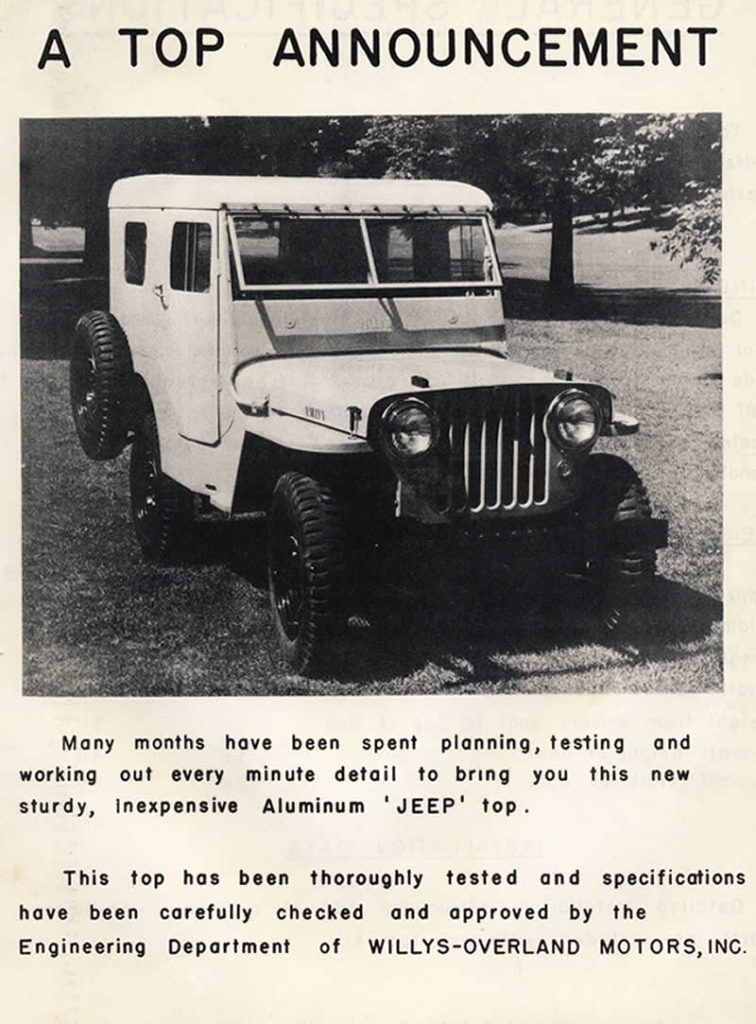

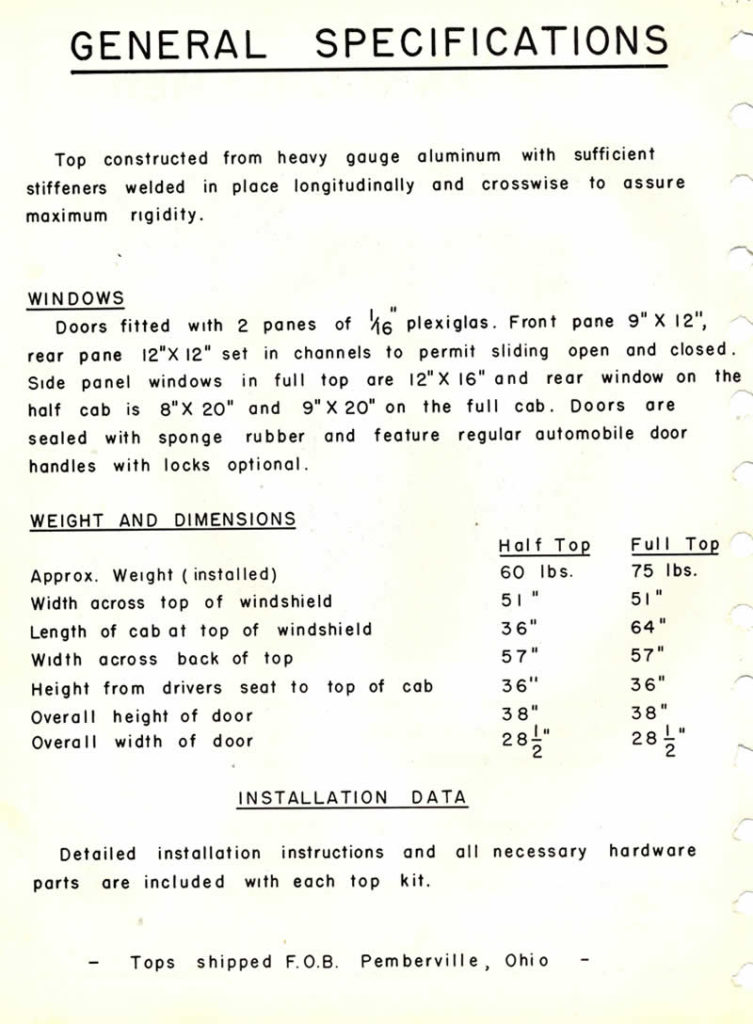

Worman quickly expanded the full cab line into four markets. He developed The “Standard” or “Regular” (half $99 or full $144), the “Mail Carrier” (half $128 or full $169), the “Military” (half $109 or full $149 – made to fit the military jeep only), and the “Super DeLuxe” insulated full cab ($199 full cab – no half cab made).
- REGULAR CAB: The aluminum tops were equipped with safety glass in the doors and plexiglass in the rear.
- MAIL CARRIER CAB: These included fingertip controls to raise and lower the door’s safety-glass windows. This also allowed the driver to rest an arm on the window ledge and extend it for signaling traffic.
- MILITARY CAB: Designed to fit military jeeps only, it was built out of heavier gauge aluminum than the other Jee-CABS. The cab had moisture-proof insulation and ½” sponge rubber along the door edges to insulate against both heat and cold. It had safety glass all around. The windows slide horizontally rather than vertically. It weighed more, too, probably similar to the 108lbs of the Super Deluxe Cab:
- SUPER DELUXE CAB: Advertised as the “Tops in Tops”, the super cab had insulation similar to the military cab. It borrowed the fingertip controlled Mail Carrier type safety glass windows from the Mail Carrier Cab that insured ventilation and maximum visibility. The top weighed more than other cabs because it used safety glass throughout. It was made of 175 individual components with 1,845 spot welds. The doors came with chrome plated handles and locks.
Here are some brochures and notes from the late 1940s related to Worman:

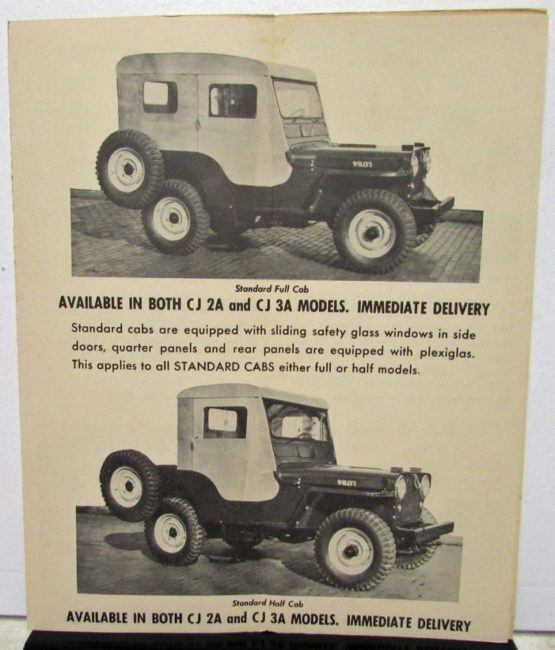
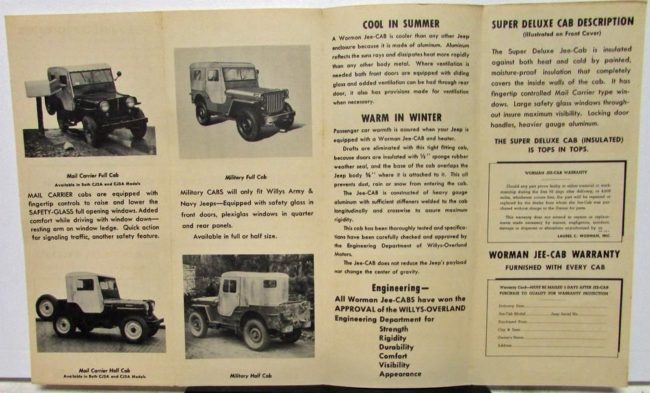 A color version of the Jee-Cab brochure:
A color version of the Jee-Cab brochure:
And a different version as published in the Willys Industrial Equipment book:
Worman’s brochure for their top-of-the-line Super Deluxe Jee-Cab:

Press photo of woman testing a Jee Cab window from 1948 in a photo that was on eBay.
In January of 1949, the Toledo Blade reported that Worman would be donating jeeps and equipment to a Future Farmers of America to cultivate and harvest on land near Toledo’s municipal airport.
COMPETITORS:
Despite Laurel’s early entry into the industry, the Jee-CAB faced significant competition. The 1947 Special Equipment book included brochures for the full cab aluminum Boston Top from the Willys New England Company, the Car Craft top from Carson Machine & Manufacturing, and the steel half and full Koenig tops from Koenig Iron Works. The Blue Star insulated aluminum top ($180), was also being produced by the Blue Manufacturing Company. Yet Worman, with its larger product line, appeared the more dominant seller in equipment and industrial books due to its large number of brochures.
By 1949, others had entered the market, including Porter & Reed, Rueben Beck, the V7 (from V7 Body Works) half and full wooden bodies, and others. It was the heyday for cab options. With his financial backing, his marketing capabilities, and his connections with Willys-Overland, Worman’s cabs should have remained a large seller compared to the competition. Unfortunately, I could find no statistics on the number of cabs sold to validate this theory.
OTHER PRODUCTS:
Despite or because of the competition, Worman expanded Laurel C. Worman, Inc., two directions. By 1950, he was selling all-aluminum pickup enclosures for trucks. Given that few of these have survived, it is probable he didn’t sell many.

Another product, one that has survived, is the Worman Parkway Conversion wagon. The need for the design was rooted in the late 1940s and early 1950s motor vehicle laws. Many residential communities did not allow delivery wagons in their areas. To solve the problem, Worman retrofitted Willys-Overland delivery wagons with side windows, making them licensable in many suburban areas. What’s not clear is whether Worman alone did these conversions or if Worman was just one customizer, as there are two general styles of Parkways. The main differentiating aspects are two screws that appear in between the two rear windows. Some Parkways have them and some don’t.

NEW WORMAN HARD TOP:
By the early 1950s, Worman has broadened their lineup, making cabs for 2As, 3As, and 3Bs:
Also by this time, Laurel’s son Ernest Worman, one of two sons (the other being Lester Lee Worman) had joined his father in business and was appearing in ads like this one. It suggests Ernest had been in the business with his father for a while:
Then in 1953, with some competitors gone, but others, like Sears, entering the field, Worman introduced a new, stylish hardtop for the CJ-3B. It had a sleek look with larger rear windows to improve visibility. The driver and passenger windows appear to slide sideways, similar to the Military Top. Again, the production numbers of the CJ-3B top remain a mystery, but it wouldn’t take a big leap to say they may not have sold well. Few seem to remain.

WILLYS & WORMAN PART WAYS:
In June of 1955, Worman and Willys Motors parted ways. Newspapers of the day simply reported the fact, without highlight why the split happened.

However, events two months later, on August 16, 1955, shed some light. At that time the Toledo Blade reported that Worman had ended his relationship with Packard also, then purchased a Pontiac dealership, leaving Toledo without a Packard dealership for the first time in years. Perhaps Worman disagreed with the directions of Packard and Willys, but more likely he saw great potential with Pontiac, a company that was outselling Willys, Kaiser and Packard combined (Pontiac sold 3.7m cars during the 1950s, while Packard/Willys/Kaiser sold a combined 1.6m).

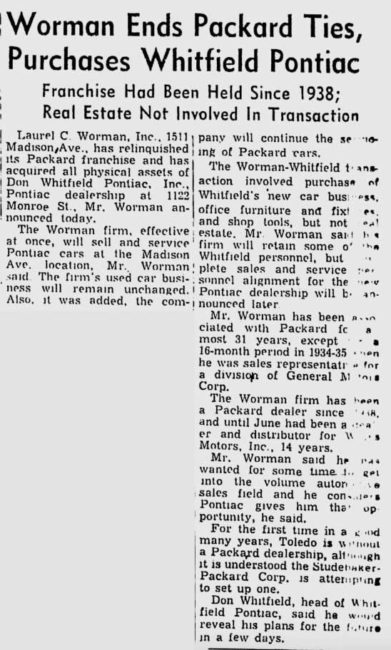
LAUREL C. WORMAN:
Despite the new dealership arrangement, Laurel continued to dabble in other ventures, including the construction of shipping boxes for Willys engines for the military. At some later juncture, Laurel and Ruth Worman moved to Glendale, California. There, Laurel passed away on November 17, 1964, at the age of 66.
While Kelly and Meyer hardtops became well known in the 1950s and 1960s, the Jee-CAB tops and brand faded into history. Much of thanks regarding their current awareness is due to Bart McNeil’s piece written for the CJ-3B page’s hardtop section.
=====
August 2017 note:
This hardtop was for sale for $250 out of Boston. I may have been a Jee-Cab or even an earlier Worman built Willys-Overland top:
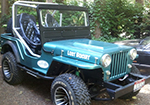
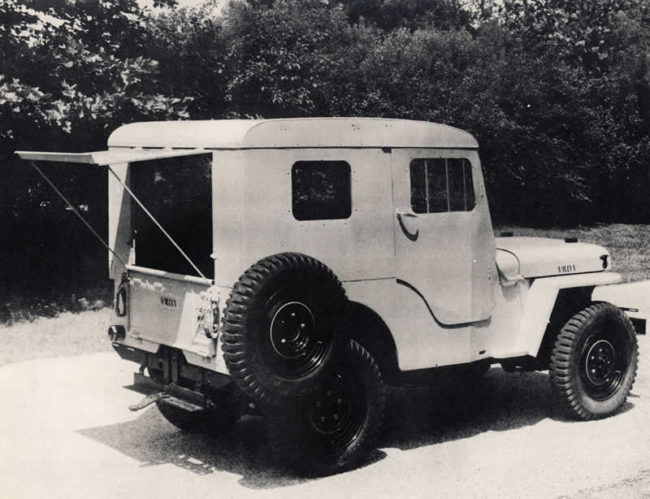

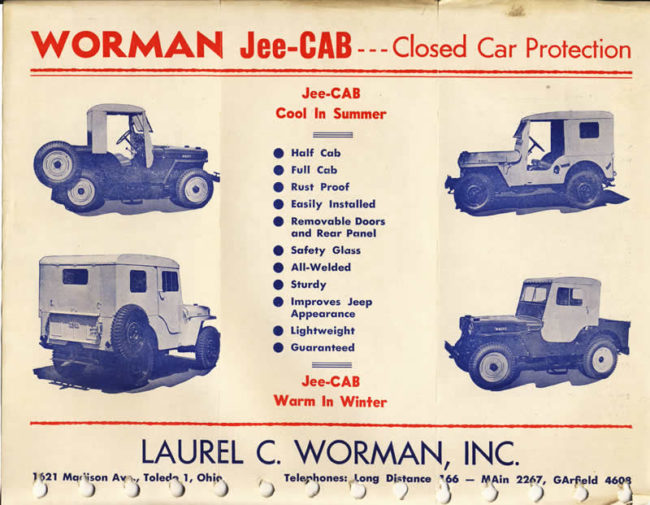


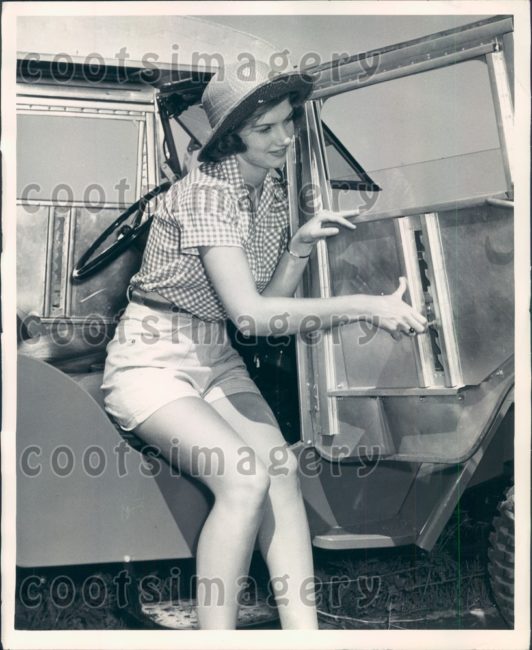





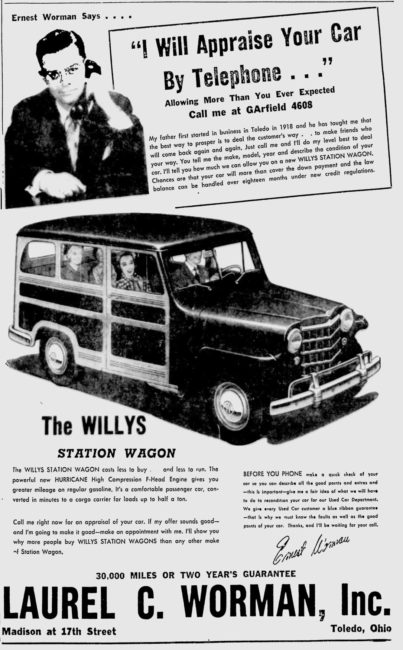
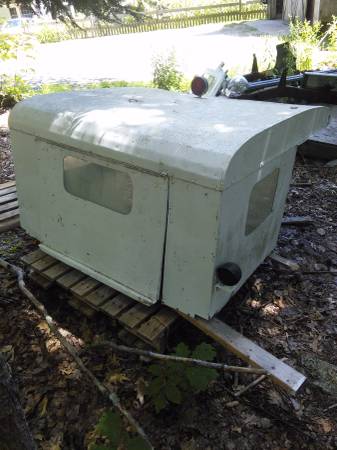
Interesting. Thanks Dave.
That was interesting…wonder what the real story is?
This was so great for me to stumble across ! Laurel was my Grandfather. 🙂
Thank You for this gem of an addition to my family history archive.
Sincerely, Tamara Lee Worman-Roberts
Juneau, Alaska
P.S.
Dear Author,
In the Bio at the end you failed to mention his other son “Lester Lee Worman”. He had 2 sons.
Thank You, Tamara Lee Worman-Roberts
Hi Tamara,
Thanks for the note. I’m happy you found it and glad it added to your family history. I’m sorry I didn’t include Lester Lee, as I never found him online. I looked for some genealogical information, especially parents and siblings, but never ran across Lester. I’ll add him to it.
I have written a more polished version of this post for an upcoming issue of Dispatcher (a vintage jeep related magazine). I’ll email you a copy of the text directly.
Thanks,
– Dave
Wonder what the difference was between a Worman Parkway Conversion and a regular Parkway Conversion. Distributor?
Dan,
If I had to guess, I’d say Worman might have been the “factory” version, while the regular Parkway was done by dealers? But, that’s just a guess.
– Dave
Interesting history. The Hillcrest at 17th and Madison still exists. Ground floor is empty according to pictures from Google Maps. The area around the hotel is mostly vacant lots, some light industrial, and quite depressed looking.
No surprise that one would want to drop Packard in 1955, even with a long history of being a Packard dealer. 1953 was pretty much the beginning of the end of Packard, after the disastrous merger with Studebaker. They were late to the V8 market, late to the automatic transmission market, and their styling was very undistinguished. 1957 was the last real Packard. There were 1958’s and 1959’s, but they were re-badged Studebakers. Pontiac, on the other hand, was the upcoming younger market brand at the time. Pontiac out-lasted Packard by 50 years.
Hi, Dave. I was thrilled to see this yesterday. You really did a fantastic piece here.
Thank You,
Tamara L Worman
Tamara,
I’m glad you enjoyed it!
If you’d like, I can arrange to get you a copy of the Dispatcher Magazine as well that has the article in it. If interested, send me your address (d@ewillys.com) and I’ll get a copy out to you.
Thanks,
– Dave
Dave, I will email you tonight. I have to say that I was impressed at the original article & twice that yesterday when I saw the final publish. It’s people like you who help make/keep history alive as well as honoring someone you didn’t even know personally of their original vision decades previous. Thank You on behalf of my entire family & myself.
Warmest Regards,
Tamara Worman
PS
I’ve got some new stuff to share with you Mining related & I’ll bet you do too ! I am all ears 🙂
Tamara, I’ll check with my friends who are Willys flat fender fans (and owners) to see if we can locate a Worman Jeep top for you, ok? Alaska Paul in Anchorage
Alaska Paul -I’d say you are one guy who’ll get something way better than fruit cake from me at Christmas if that would take place ! And thank you. That makes me smile knowing someone wants to see my dream a reality too 🙂